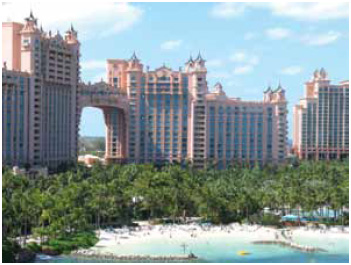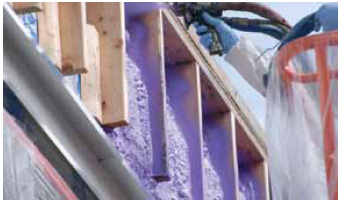Chemistry: A Major Driver of Building Performance
4. Fenestrations
Some of the newer high-performance advancements for building envelopes have made major improvements to the efficiency of the weakest links in the building envelope — the windows and doors. One such advancement is called warm edge thermo plastic spacer (TPS), which is a combined adhesive and sealant based on polyisobutylene that provides a flexible, waterproof, durable spacer that is resistant to UV radiation. Adopted by a growing number of window manufacturers in recent years, TPS combines very low moisture transmission rates and low gas permeability values (< .1 percent/year) with strong adhesion and great elasticity (versus aluminum, stainless steel, etc., spacers) to provide energy-saving features and high resistance to mechanical and thermal stress caused by a variety of environmental conditions. TPS enable windows to be built in virtually any shape or size and with any type of window frame — including wood, vinyl, fiberglass and aluminum.
Furthermore, when compared with more traditional dual-pane spacer technologies, TPS have the lowest overall window U value, which means it has the best rating for heat transfer resistance (insulation) characteristics — in addition to the lowest fogging potential. As a result, TPS has the best environmental footprint in the categories of energy consumption, emissions, resource consumption and land use. (See TPS ecological footprint diagram.)
ENERGY STAR performance levels will demand better window performance as of 2012. TPS can help meet these new standards by improving energy efficiency by up to 10 percent compared with metal-spaced dual-pane windows that are identical in every other way.
Another advancement is the improvement of insulated exterior doors. Both pedestrian egress doors and larger garage doors are now being made with cores of rigid or high-density polyurethane foam (PU). This technology allows doors to offer an R-value of up to 14 — a significant improvement over a traditional 2-inch solid wood door, which offers R 2.33 (http://www.sizes.com/units/rvalue.htm). Polyurethane cores are lightweight, but very strong, providing increased structural strength and long-term durability in high-traffic areas or “rough-handling” environments such as schools.
Interior fire doors also benefit from advances in chemistry. Specially formulated alkali silicate blends are used to create lightweight panels for fire doors that expand under the effect of heat and the resulting generation of foaming pressure. The non-combustible, heat-insulating foam created in this process prevents fire and smoke from spreading to other rooms for a given time span. Similar chemistry is employed in fire-protection glazing, as well as in fireproof bulkheads for pipes, cables or ventilation elements.
 |
|
Two years after the Atlantis Hotel and Casino was clad using EIFS , the landmark was buffeted by Category 5 Hu rricane Floyd, yet suffered absolutely no damage to the cladding.. |
5. Air & Weather Barriers
Air and weather barriers fall into three classifications:
- Water-resistive barriers are designed to keep liquid water out of walls. These barriers can be permeable or impermeable.
- Air barriers are intended to seal the roof, walls and foundation so that air does not infiltrate or exfiltrate. The No. 2 source of water intrusion into a building (behind bulk water intrusion such as rain or melting ice) is humidity traveling with air. Air barriers can also be vapor permeable or impermeable.
- Vapor barriers prevent moisture from permeating through the barrier material into the wall assembly. Vapor barriers prevent heat and water from traveling from high concentration to low concentration areas.
Air and weather barriers are important, primarily, because there is so much air and moisture flowing in and around most buildings and houses. During the winter months, water leaks, humidity from the clothes washer, showers and steam from cooking — even breathing — all create warm, moist air that will find the path of least resistance to where there is no heat and moisture. It can and does go anywhere and will take any circuitous route. Stack effect (the rule that hot air rises), wind effect caused by external elements and mechanical effect (often positive pressure in the form of make-up air) all exacerbate air migration rates. The taller the structure, the greater impact these effects can have.
As the air passes from a warmer to a cooler space it cools, and the moisture content drops off onto wood or metal or any other condensing surface, sometimes inside a wall or unsealed attic space. Can lights (housed in the ceiling) are a primary path for this migrating air traveling to the attic of a house. Wherever there is condensation, mold can result. Summer months have everything flowing in reverse and the basement and crawl space under a house come into play. Vapor barriers do stop the flow of moisture — when they are used — but may not prevent uncontrolled air migration.
When moisture goes where it shouldn’t, durability of building materials can be affected. Many materials are susceptible to rot, and many fibrous insulation materials can act as sponges that hold moisture. Indoor air quality is affected if air movement is not controlled: pollens get inside. The room over the garage is frequently cold, with the introduction of exhaust fumes and other VOCs into the living space posing a health risk to inhabitants. Air leakage can also cause back drafting and CO problems in a house.
 |
|
The City of Lubbock, Texas, gathered and analyzed three years of cost data on 100 homes built using ICF s. The results showed the monthly energy costs for the ICF homes were $50 to $75 — one-third the $150 to $200 monthly costs for non-ICF |
Energy usage goes up since as much as 40 percent of it lost to air leakage and convection looping. Energy costs — to heat and cool and condition the air as well as GHG emissions — go up as well. In fact, a groundbreaking report from the National Institute of Standards and Technology (NIST), “Investigation of the Impact of Commercial Building Envelope Air tightness on HVAC Energy Use,” indicates that continuous air barrier systems can reduce air infiltration by more than 60 percent and energy consumption by up to 40 percent compared to buildings with typical air leakage rates.
Air barrier performance is defined by the air leakage rate — L/(s•m²•Pa) — the rate of airflow (L/s) driven through a unit surface area (m²) of an assembly by a unit static pressure difference (Pa) across the assembly. Several materials qualify as air barrier materials. Two high-performance air/weather barrier materials include:
A one-component, fluid-applied, vapor-permeable, air/water-resistive barrier membrane can be spray, roller, brush or trowel applied directly to above-grade wall substrates. One-component barriers resist air/water flow at 0.0049 l/m2 @ 75 Pa.
A two-component, closed-cell SPF (spray polyurethane foam) air/weather barrier can be spray applied at a rate of .5 inch to 2 inches maximum per pass with typical installations being at a maximum thickness of 4 inches and resulting R-values at 6.7 per inch of applied material. This material offers an air leakage rate of 0.000025 l/m2 @ 75 Pa. The two-component air/weather barrier system can be applied to glazing, metal, wood and concrete block among others. In some jurisdictions, SPF qualifies to do three jobs in one application — air barrier, vapor barrier and insulation.
Properly installed/applied, air and weather barriers can:
- eliminate uncontrolled air leakage;
- reduce HVAC requirements;
- reduce energy use by 3 percent-36 percent, depending on the building design and proper installation of the complete, continuous air barrier system;
- last for the life of the structures, as they are designed to do;
- prevent moisture intrusion due to air infiltration and exfiltration; and
- stop moisture-vapor transfer, condensing, mold and mildew within the wall cavity.









